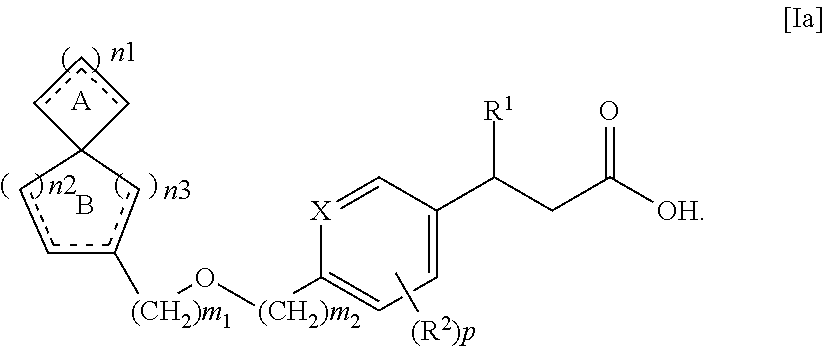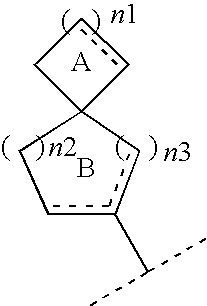Spiro compounds and pharmaceutical use thereof
a technology of agonist activity and spiro compound, which is applied in the direction of drug composition, metabolic disorder, cardiovascular disorder, etc., can solve the problems of variable pathognomonic complexity, and achieve the effect of impaired glucose tolerance and impaired fasting glucos
- Summary
- Abstract
- Description
- Claims
- Application Information
AI Technical Summary
Benefits of technology
Problems solved by technology
Method used
Image
Examples
example 1
Preparation of (S)-3-[4-(spiro[5.5]undec-2-en-2-ylmethoxy)-phenyl]-hex-4-ynoic acid
[0320]
Step 1
[0321]To a solution of cyclohexanecarbaldehyde (10.7 mL) in toluene (100 mL) were added successively methyl vinyl ketone (15 mL) and concentrated sulfuric acid (0.1 mL). The reaction mixture was stirred at room temperature for 1 hour and then heated under reflux while stirring for 4 hours. After cooling down to room temperature, saturated aqueous sodium bicarbonate solution was added to the reaction mixture, followed by separation of the organic layer. Then, after the aqueous layer was extracted with toluene, the organic layers were combined, washed with saturated brine, dried and concentrated. The residue was purified by column chromatography on silica gel (ethyl acetate:hexane (volume ratio)=1:20 to 1:12) to give spiro[5.5]undec-1-en-3-one (8.9 g).
[0322]1H-NMR (CDCl3) δ: 1.63-1.45 (10H, m), 92 (2H, t, J=6.5 Hz), 2.44 (2H, t, J=6.5 Hz), 5.89 (1H, d, J=10.2 Hz), 6.85 (1H, d, J=10.2 Hz).
Ste...
example 2
Preparation of (S)-3-[4-(spiro[5.5]undec-2-en-2-ylmethoxy)-phenyl]-hex-4-ynoic acid sodium salt
[0351]
[0352]To a solution of the compound (0.77 g) obtained in Example 1 in ethanol (7 mL) was added 4N aqueous sodium hydroxide solution (0.5 mL), followed by stirring at room temperature for 30 minutes. The reaction mixture was concentrated, and after addition of ethanol to the residue, the reaction mixture was further concentrated by azeotropic distillation twice (hereinafter abbreviated as “distilled azeotropically with ethanol”). The residue was dried in vacuo to give (S)-3-[4-(spiro[5.5]undec-2-en-2-ylmethoxy)-phenyl]-hex-4-ynoic acid sodium salt (0.73 g) as the desired compound.
example 3
Preparation of (S)-3-[4-(spiro[5.6]dodec-2-en-2-ylmethoxy)-phenyl]-hex-4-ynoic acid
Step 1
[0353]In the same manner as in Steps 1 to 7 of Example 1, spiro[5.6]dodec-2-en-2-yl-methanol was obtained from cycloheptanecarbaldehyde.
[0354]1H-NMR (CDCl3) δ: 1.65-1.20 (14H, m), 1.78-1.80 (2H, m), 2.00-2.06 (2H, m), 3.98 (2H, s), 5.65-5.68 (1H, m).
Step 2
[0355]In the same manner as in Steps 8 to 9 of Example 1, the desired (S)-3-[4-(spiro[5.6]dodec-2-en-2-ylmethoxy)-phenyl]-hex-4-ynoic acid was obtained from the compound obtained in the above Step 1.
PUM
| Property | Measurement | Unit |
|---|---|---|
| temperature | aaaaa | aaaaa |
| temperature | aaaaa | aaaaa |
| temperature | aaaaa | aaaaa |
Abstract
Description
Claims
Application Information
 Login to View More
Login to View More - R&D
- Intellectual Property
- Life Sciences
- Materials
- Tech Scout
- Unparalleled Data Quality
- Higher Quality Content
- 60% Fewer Hallucinations
Browse by: Latest US Patents, China's latest patents, Technical Efficacy Thesaurus, Application Domain, Technology Topic, Popular Technical Reports.
© 2025 PatSnap. All rights reserved.Legal|Privacy policy|Modern Slavery Act Transparency Statement|Sitemap|About US| Contact US: help@patsnap.com



